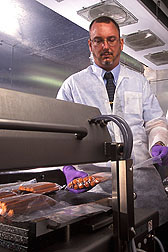This page has been archived and is being provided for reference purposes only. The page is no longer being updated, and therefore, links on the page may be invalid.
|
|
Inventors Win ARS Technology Transfer Honors
By Marcia WoodFebruary 11, 2009
WASHINGTON, Feb. 11--Delicious new apricots, a better way to keep hot dogs and sausage safe to eat, and simpler ways to produce catfish are among the innovations that have garnered technology transfer awards for Agricultural Research Service (ARS) scientists at laboratories nationwide. ARS is the principal intramural scientific research agency of the U.S. Department of Agriculture.
For moving their research-based technologies out of the laboratory and into the marketplace, 15 ARS experts and their university and corporate co-investigators were honored yesterday by the agency at a ceremony here.
"Agricultural research is fundamental to the strength of our farm sector, and holds the key to improving nutrition, fostering the development of new sources of renewable energy, and creating new sources of revenue for our farmers and ranchers," said Agriculture Secretary Tom Vilsack.
"Americans everywhere benefit from this research," said ARS Administrator Edward B. Knipling.
Top honors for outstanding technology transfer went to:
- The Flash Pasteurization Research Group, for a technique that uses bursts of steam to improve the safety of hot dogs and sausages. Microbiologist Christopher H. Sommers, chemical engineer David J. Geveke, mechanical engineer Neil M. Goldberg, and Michael F. Kozempel (retired) with the ARS Food Safety Intervention Technologies Research Unit, Wyndmoor, Pa., shared the honor with corporate collaborator ALKAR-RapidPak, Inc., of Lodi, Wis.
- The iBMC Consortium, for discovering and commercializing their "BovineSNP50" genotyping assay for improving the genetics of dairy and beef cattle. Geneticists Curtis P. Van Tassell and Tad S. Sonstegard of the ARS Henry A. Wallace Beltsville (Md.) Agricultural Research Center, and chemist Timothy P.L. Smith and biological science lab technician Renee A. Godtel of the agency's Roman L. Hruska U.S. Meat Animal Research Center in Clay Center, Neb., teamed with Marylinn Munson and Cindy Taylor Lawley of Illumina, Inc., in San Diego, Calif., and collaborators from George Mason University, Manassas, Va.; the University of Missouri-Columbia for this research.
- The Catfish Industries Support Team--comprised of ARS fish biologist Eugene L. Torrans at the ARS Catfish Genetics Research Unit in Stoneville, Miss., and a Mississippi State University collaborator--for findings that boost survival of catfish eggs and young at hatcheries.
* The AGWA team, with hydraulic engineer David C. Goodrich and hydrologist Carl L. Unkrich of the ARS Southwest Watershed Research Center in Tucson, Ariz., for helping water districts, homeowners and others across the country conserve water by using the team's computer-based "Automated Geospatial Watershed Assessment" technology. The Tucson scientists’ AGWA teammates are from the U.S. Environmental Protection Agency in Las Vegas, Nev.; the University of Arizona-Tucson; the University of Wyoming-Laramie; the University of Nebraska-Lincoln, and CH2M Hill in Albuquerque, N.M..
* Ulrich R. Bernier, a chemist with the ARS Center for Medical, Agricultural and Veterinary Entomology in Gainesville, Fla., for procedures that ensure soldiers’ uniforms are properly insect-proofed to protect against mosquito-transmitted disease.
* Joe W. Dorner, a microbiologist with the ARS National Peanut Research Laboratory in Dawson, Ga., for enabling the peanut industry to use ARS' Afla-Guard technology to protect the crop against aflatoxin, a contaminant.
* William A. Dozier III, formerly with the ARS Poultry Research Unit in Mississippi State, Miss., for quickening transfer of new, science-based technologies to the U.S. poultry industry.
* Craig A. Ledbetter, a geneticist at the ARS San Joaquin Valley Agricultural Sciences Center near Parlier, Calif., for developing "Apache," "Helena" and other superb apricots.


